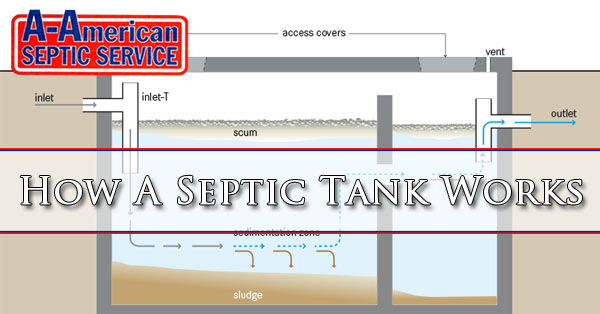Septic Systems are found under the ground in wastewater treatment plants, and they are usually used in areas that do not have a centralized sewer system. In order to treat the waste water that comes from residential plumbing, which is produced from kitchen drains, laundry, and bathrooms; a combination of nature itself and modern technology is used.
The most typical septic systems includes a septic tank, and a drain-field, or it may be a soil absorption field or leach field. Organic matter is digested by the septic tank and then separates it into a floatable matter (e.g., oils and grease), including the solids that come from the waste water itself.
A liquid, which is known as ‘effluent’ is discharged from the soil-based systems of the septic tank by means of a series of perforated pipes that have been buried under a leach field, or leaching chamber, and some other specialized units that are designed for slowly releasing the effluent into either the soil or to the surface of the water.
There are some alternative systems which use pumps and sometimes gravity, which helps the effluent to trickle out of the septic tank and through the sand and organic matter, such as sawdust and/ or peat. And constructed wetlands, even different media are sometimes used in removing or neutralizing pollutants such as pathogens that can cause diseases, nitrogen, phosphorus, are among many more contaminants that may be present.
There are a few alternative systems that have been designed for evaporating waste water and/ or disinfecting it prior to discharging it into the soil, or to the surface of the waters.
The specifics of how the typical septic system works:
- The water that runs back out of your home goes through a drainage pipe, this is the main drainage from your home that takes the used water to a septic tank.
- The septic tank that the used water goes to is sealed in a water tight container that is buried under the ground and is made from either concrete, fiber-glass, or polyethylene.The job of the septic tank is to contain the waste water until the solids settle to the bottom of the tank, forming sludge and the oil, grease, and other liquids float to the surface, referred to as scum.The septic tank consists of different compartments, having a t-shaped outlet to prevent any sludge and/or scum from seeping out of the tank (keeps it from getting to the drain-field area).
- Once the waste water has had enough time to settle it along with the effluent, it is then released into the drain-field.
- The drain-field has been constructed and excavated in soil that is unsaturated, and in a field that is shallow, and has been covered up. Next, the pretreated waste water gets released through the piping onto a porous surface, allowing the waste water to be filtered from the soil.The waste water is then accepted, treated and dispersed by the soil and then percolates on through the soil, eventually, being released into the ground water.If the drain-field is ever overloaded, having more liquid than it can handle, it would cause it to flood and the sewage could flow up to the ground surface and/ or create a back-up in the toilets and sinks.
- Finally, as the waste water is percolating in the soil the harmful coliform bacteria, nutrients, and viruses, are naturally removed. The coliform bacteria are bacteria that predominantly inhabits on the inside of the human intestines, they can also inhabit on the inside of different warm blooded animals. This indicates that there is combination in the human fecal.
Does your home use a septic system?
You probably will know if you have a septic system. Generally when you are buying a home you will find out what type of solid waste disposal system the house has installed. If you aren’t sure, read the clues below to know if you have city or septic waste disposal.
However, for those who do not yet know, below are some definite signs that you do:
- Your water comes from a well.
- There is no water meter to your home.
- There will be “no-charge” showing up on either your water bill or your property taxes.
- If any of your neighbors have septic tanks, it is very likely that you do, too.
After finding out that you are using a septic system, you will be able to locate it by doing the follow things below:
- You can look over the ‘as built’ drawing, which you can usually get from your local court house.
- Check to see if your yards have any lids a top of the ground and/or manhole covers.
- Contact a professional to assist you in finding it.
*Pay Attention To The Signs Of Septic Tank Failures!*
If you should notice any of the following you should contact a septic tank professional right away:
- Smell coming from your septic tank is not always going to be the first sign that it is malfunctioning.
- There is waste water backing up in the household drains.
- Dry weather or not, if you notice spongy, bright green grass on and around the drain-field.
- There is muddy soil or water gathering around the septic system, or it may be in your basement. There is a strong stinky smell coming from around your septic tank, and the drain-field area.
Septic Tank Service Arizona
Let A-American Septic Service help you find the right septic system for your application. Call 602-254-5448 today to discuss which type of system will work best for your application and help with septic tank design & installation.







